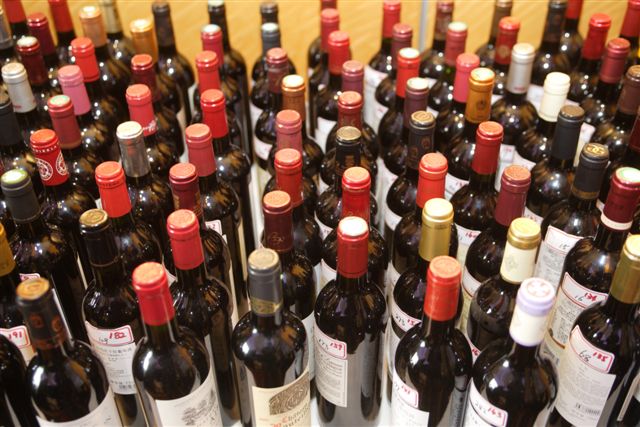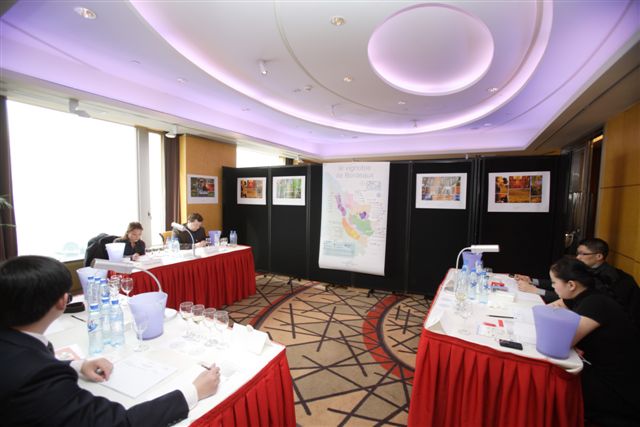
By Jim Boyce
I sat on the Simply Bordeaux 2009 panel in Shanghai two weeks ago to taste 340 wines in the RMB70-350 range and help determine the “top 100” available in China. In my first post, I looked at the physical and mental challenges of trying so many wines in less than three days (my gums recovered about a week later). In this one, I’ll explain how the process works.
When I arrived at the tasting at the Hilton just before 9 AM on a Monday, I knew three things:
1) I had tried a wide range of Bordeaux, from Grand Cru to plonk, with plenty of stuff in between, and have thus had mixed experiences. (I also distaste the largely futile efforts of Chinese wine producers to emulate the Bordeaux style, but that’s another story.)
2) I had not tried this many wines in this little time and planned to keep fresh by going to bed early. (Unfortunately, 2 AM was the earliest I turned in).
3) I had read the section on tasting in The Complete Wine Course by Kevin Zraly and decided I would smell each wine three times, then taste, spit, and score. Call it the “sniff, sniff, and sniff, savor, spit, and score” strategy. (As noted in the first post, this didn’t exactly work out.)
–
Shortly after I arrived, I learned three more things:
1) A liver transplant would be included as part of the event. We were to score each wine out of 20, with up to three points for color, six for smell, six for taste, and so on.
2) Three other people would taste all of the wines: Li Dimei, a winemaker known for his work at Sino-French Demonstration Vineyard; Yvonne Chiong, former sommelier at Three on the Bund’s Jean Georges and now a consultant, and Kelvin Tay, director of wine at Pudong Shangri-la. (Both Li and Chiong contribute to this blog.)
3) I was the first consumer to ever sit on the panel.
–
We collectively tried a white and a red, and talked about the smell, taste, and so on in order to have common reference points for the other wines. Then, we started.
Each of us faced four glasses, a spittoon, a scoring booklet, and plenty of water and bread. The servers came with two bottles each and quietly announced the numbers as they filled our glasses. For me, it then became a constant process of sniff, sniff, and sniff, savor, spit, and score. I focused more on the total score and comments than on breaking the score down by components, otherwise I would have lagged even further behind the other judges.
As we finished a flight, we emptied our glasses and received four new pours. We did this over and over and over again. That morning, we did the white, rose, and sweet wines, which had enough collective acidity to make our molars ache. As we finished, a co-judge said, That was the easiest part. It was true: We now faced nearly 300 reds.
After lunch, we increased our flights to eight glasses, which meant the pouring pace increased, one that made my head swim at times. I swung between focusing on sniff, sniff, and sniff, savor, spit, and score and drifting off to thoughts like, I bet the pouring guys are annoyed because I’m slow, I’m amazed I haven’t spit on myself, and so on.
Eventually, focus beat drift and I tried about 130 wines on Monday, going back to make sure my scores were legible and noticing most fell in the 11 to 16 range.
Tuesday turned out to be the hump day, with 152 wines, but I stuck to my method.
I also scribbled down some notes to record the thought process of a consumer – or at least of me – on such a panel. Here are a few:
– #153: The first corked wine of the day. And I caught it, too!
– ~150s: One wine is oxidized. But what if I like oxidized wine?
– #160: My scoring range is narrowing. Am I getting tired? Being fair?
– #176: Tannins! I may need a gum transplant after this.
– Reminds me of Dragon Seal Huailai Reserve. Bad to write that down?
– Maybe the pourers could break a few bottles and slow things down.
– #190: I’m retrying a lot of the wines so I’m actually tasting much more than the other judges.
– Yvonne’s teeth are white, mine are blackish purple. She says I should run my tongue along them after each wine. Nice time to tell me!
We tasted throughout the afternoon and started again the next morning, with the last wine – served an hour before lunch – bringing a sigh of relief. I then checked my scores to make sure they were legible and in order, and handed in the booklet.
A few conclusions:
– I found the wines better than I expected and considered few of them “undrinkable.”
– I also found that fewer were corked than I expected. I would guess about a half-dozen.
– The staff did a good job of keeping me on track and ensuring I knew the number of each wine. The people from SOPEXA, The Bordeaux Wine Council, and Burson-Marsteller, which handles the PR, were helpful.
– And the judges made a big difference. I have experienced some attitude on other panels, but Li, Chiong, and Tay were patient and fun, and offered encouragement during the breaks, lunches, and dinners (the latter being one reason I didn’t make it to bed by on time).
– And I didn’t spit on myself once.
A final observation: I learned what these wine judges like to eat after a big tasting: spicy food, and the hotter it is, the better. We hit a nearby Indian restaurant and I have to say the aromas and flavors of that fish curry were a nice change of pace.

Grape Wall has no sponsors of advertisers: if you find the content and projects like World Marselan Day worthwhile, please help cover the costs via PayPal, WeChat or Alipay.
Sign up for the free Grape Wall newsletter here. Follow Grape Wall on LinkedIn, Instagram, Facebook and Twitter. And contact Grape Wall via grapewallofchina (at) gmail.com.

@ Madison,
Mouthwash, eh? I’ll have to try that one!
As for the results, they should be out next month as a booklet and as a pdf, so I’ll post the latter here.
And we also had the UGC tasting here – agreed, it is a challenge to work through all those wines in a a few hours (I only tried about 40)!
Cheers, Boyce
Thanks Eperk!
Jim
Well written
Sounds intense but great fun. Very curious as to the results… Could you share with us, Jim?
Had my share of tanning bombardment 2 weeks ago at a Union des Grands Crus de Bordeaux tasting of 05/06’s in NYC, tasting over 100 wines over 2 vintages in a short 3-hr span. Mouthwash with water and chewing down mini-pizza helped greatly.
Most amusing / humbling part is seeing the drastically different notes I took on the same couple wines on re-tasting 2 hours later…